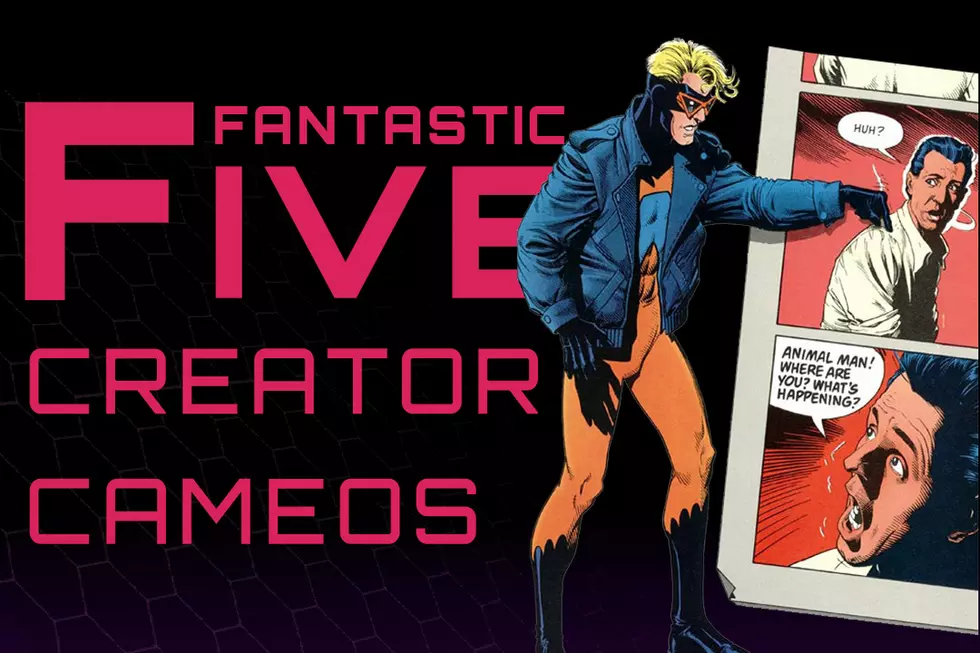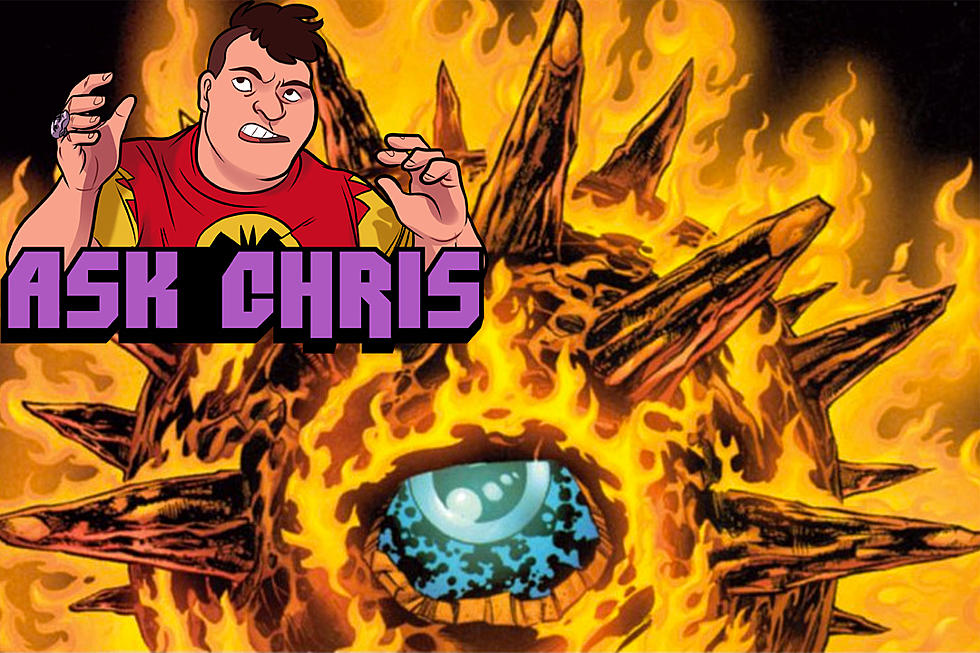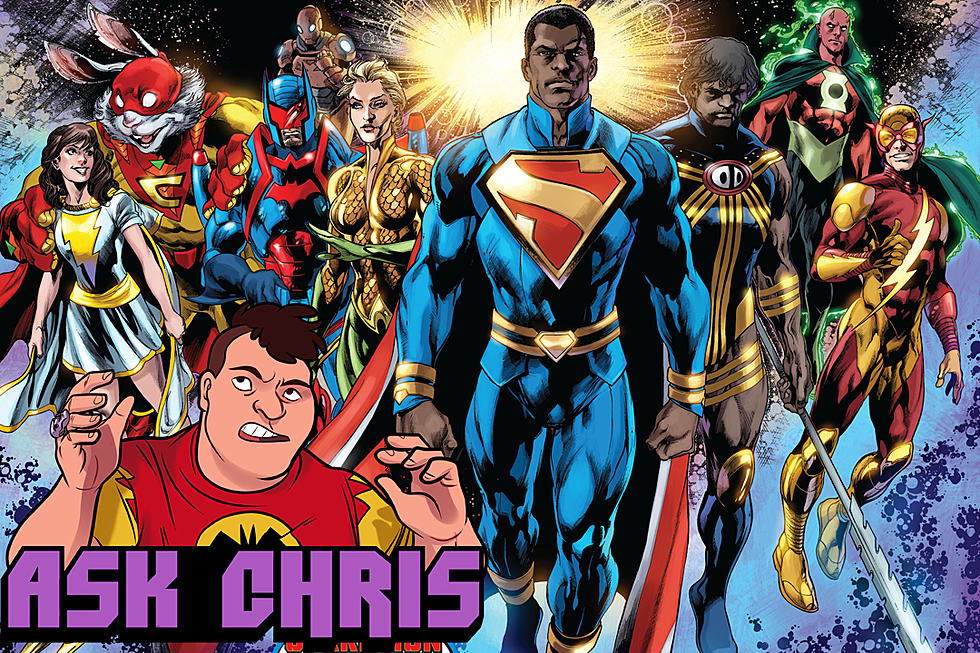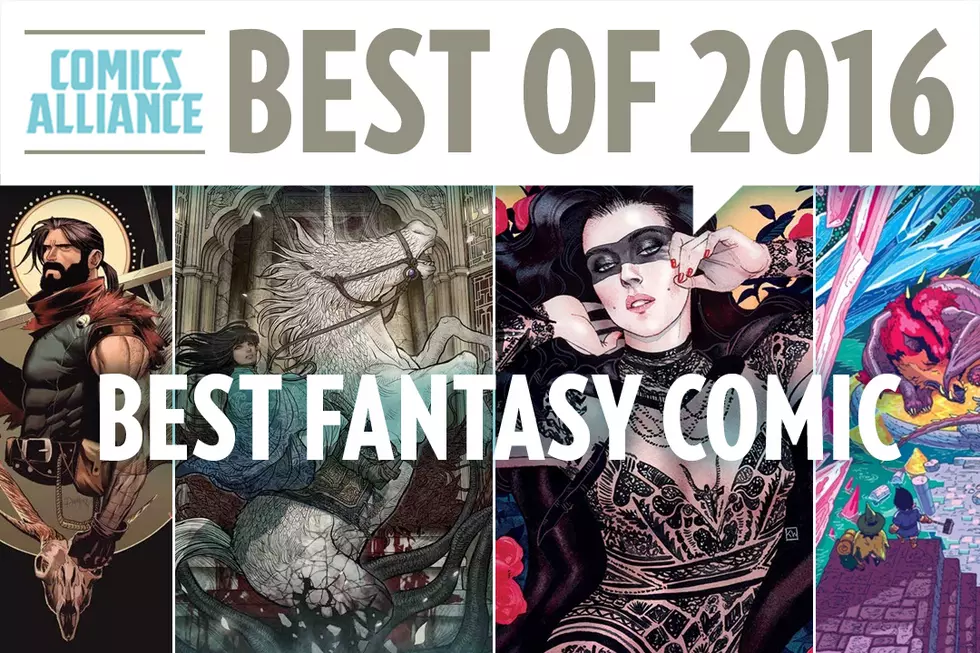
Ask Chris #1,000,000: DC’s Greatest Crossover
Q: Why is DC One Million the best crossover ever? -- @SerialWordsmith
A: Whenever I'm asked about my favorite DC crossover, the one that I always go with is Invasion!, and I think there's a pretty good argument you can make. It's done in three oversized issues, so it's quick but still feels like an epic story since they're all 80-page giants, it has a great use of some often-neglected parts of DC's cosmic side, and there are pretty fantastic tie-ins from creators doing career-best work on books like Suicide Squad and Animal Man, and it really did add something interesting to the DC Universe.
Then someone mentions DC One Million and I realize that yeah, I'm wr-- I'm mista-- I'm misremembering things, because it's definitely the best. I mean, it's not just the best DC crossover, but it's probably the single best crossover in all of superhero comics.
I think the reason that I always forget about it is that, in my head, I don't think of it as a "crossover" as much as just being part of the great late '90s JLA run by Grant Morrison, Mark Waid, Howard Porter and, in the case of One Million, Val Semeiks. It definitely ties into that run, and since Morrison was the architect behind it and it tied into his overarching story more than anything else, that makes sense, right? Except that it's definitely a crossover. I mean, it ran through every single DC Comic that month, unifying them in both storyline and in how the comics actually looked, with a unifying trade dress and everything. That's kind of the textbook definition of what a crossover is.
If you're not familiar with it, One Million was basically a cross-time team-up in the vein of the old Justice League/Justice Society "Crisis" stories. The difference was that instead of "our" League teaming up with heroes from the past (which Morrison would eventually get around to doing in "Crisis Times Five," where they teamed up to battle a threat from the Fifth Dimension) the JLA of 1998 was the team from the past, teaming up with their counterparts from the far, far future.
Specifically, they were from the year 85,271 AD, arriving to invite the first Justice League to the future for a cross-time celebration of the original Superman's return after thousands of years from his Fortress of Solitude in the sun.
Those of you who are good at math may have already figured this out, but the gimmick here is that the year 85,271 is exactly one million months after the debut of Action Comics #1 in 1938, and every DC Comic that came out that month was meant to be the one millionth issue of that comic, which just happened to be crossing over with all these old characters from 1998 in a tribute to their past.
Admittedly, that stretches credibility when you consider that this was a future where, for instance, a Martian Manhunter solo series ran for one million issues, but hey. A lot of things can change in 830 centuries. Maybe he held down a weekly for a while sometime in the distant future. Who knows.
Either way, I love gimmicks like that, whether it's the zero issues that retold the origins, or Marvel's -1 "Flashback" issues that were meant to tell stories from before the origins, or whatever. It's a great concept, playing with the forms of the medium, and even though the "futuristic" covers of the #1,000,000 issues could not look more like they came from 1998 if they were being handed to you by the Spice Girls on rollerblades.
This, by the way, is something I have always wanted to happen to me. Y'know, just in case you were wondering.
Anyway, I remember hearing -- and I'm sure that I've said this before when talking about the crossover -- that one of the reasons it all worked so well was that Morrison had actually plotted every single issue, but in retrospect, that sounds... well, it sounds physically impossible, especially given that there's no way anyone but Garth Ennis could've come up with the plot of Hitman #1,000,000, which is basically 22 pages built around the line "Oh my God, I turned my ass into a hand grenade!" But at the same time, the books really work well as this unified look at this extremely distant future where entire cultures are built around superheroes. So, I did something that 16 year-old Chris would faint if he knew was a thing that was possible for our future. I just asked Mark Waid about it.
According to Waid, the notion that Morrison plotted every issue is "an overstatement. As I recall, he did a huge document that explained/suggested what he needed in each of the crossovers, but that's kinda S.O.P. with these things." That makes a lot more sense -- the themes are there, and stuff like Starman 1,000,000, where the idea of legacy and whether it's possible to reject a heroic identity that you're born into rather than one that you chose, is central to both the plot of the crossover and to the ongoing plot of Starman as a whole. I imagine there was way more collusion between Morrison and James Robinson and Peter Snejbjerg when it came to that one. Gunfire One Million and his explosive hindquarters, probably not so much.
That said, the core series, the four issues that came out weekly that focused on the main storyline? Those things have Morrison's fingerprints all over them in the best way possible. Mainly, it comes down to the idea that One Million is a shockingly optimistic story -- which is weird since it opens with Montevideo, Uruguay getting blown up by a weaponized Rocket Red suit, killing over a million people:
Incidentally, here's how bad I am at real-world geography: Until someone wrote into JLA a few months later from Uruguay to talk about how freaked out they were to find that their hometown had been nuked in a DC Comic, I thought Montevideo was fictional, like Gotham or Metropolis. I mean, "Montevideo?" Video Mountain? Tell me that doesn't sound like something Jack Kirby came up with in Forever People or whatever. But no, it's very real. It is in fact the capital of a country. Meanwhile, I have a map of Gotham City from a DC Universe RPG supplement pretty much memorized. Clearly, my knowledge is what you might call "extremely specialized."
But yeah, this is a story that opens up with this extremely violent act of wholesale slaughter, and not only that, but it's wholesale slaughter perpetrated by taking something from the previous era that was lighthearted and fun -- in this case, the Rocket Red suits that were seen in Giffen, DeMatteis and Maguire's Justice League International -- and turning them into something hugely ultraviolent in order to give a catastrophic weight to the story. It's exactly the kind of thing that was the foundation of the grittier comics of the time, and, to be honest, that DC is basing a huge chunk of their current marketing strategy on even today. It seems phenomenally cynical, but like most things that Morrison does, there's a level that only really comes together as the story goes on.
It's worth noting that one of the primary villains of One Million, along with Solaris the Tyrant Sun, is Vandal Savage. He's the one that sends the Rocket Reds, stuffed with the bodies of the (Teen) Titans, out in a superheroic nuclear strike.
That's very important, for the simple reason that Vandal Savage is an actual caveman. He is, for all intents and purposes, the past, personified, and he's the one causing all this brutal destruction, bragging about destroying the world by using the children of superheroes as his chosen weapon. You know, just in case it wasn't obvious that this was a story about the past and the future colliding and what that meant for superheroes.
But here's the thing: While it opens with grim death and destruction, it ends with a celebration -- if you want to get specific about it, it quite literally ends with a doomed planet returning to life and true love conquering even eight hundred and thirty centuries to save the day. And there's a beautiful message there.
The stuff about Montevideo being blown up, the wholesale destruction and cynical references to a sillier past, all that stuff is happening now, in the present, whether that present is 1998 or 2014. But in the future? In the future, things might still be bad, but they're going to celebrate the past instead of being ashamed of it. It's something that comes up again and again over the course of the four issues, and, like most of Morrison's superhero comics, it's not particularly subtle:
And just to put the exclamation point on it, the problems in this story are solved in the most superheroic ways possible. It's not just Martian Manhunter tearing through a gigantic Nazi supertank, and it's not just the ultimate twist to the time travel stuff that comes on the final page, either. It's not even that this comic involves building a giant computer sun and then punching it.
It's one of my all-time favorite moments in superhero history, when Superman One Million quite literally fights his way back to the future by punching a hole in time with his bare hands.
That's awesome. And it all ties into the overarching theme, that the grim cynicism of the present is just another barrier that we have to get through, by trusting ourselves and doing something new, something that celebrates the past even as it's forging ahead. We, as readers and creators and people who believe in what these characters are saying, have to punch through to a better future. That's how we save the present: By turning it into the better world we all want it to be.
That's a recurring theme in Morrison's JLA -- I'm awfully fond of talking about the climax to World War III, his last story, where everyone on the planet gets super-powers and all unanimously choose to do the right thing because of the example set by Superman -- but it's not quite the end of the story. One of the most interesting things about One Million -- which, again, came out in 1998 -- is how much groundwork is laid for Morrison and Frank Quitely's All Star Superman, which would come out almost a decade later.
Some of the stuff is obvious -- Solaris shows up, for instance, and Superman 1M makes an appearance in there too -- but there are so many connections there that it's impossible not to realize how tightly Morrison was playing a long game with his Superman stories.
Like, say, the off-hand remark about how commonplace these cross-time team-ups are...
...and how that exact story takes place in the pages of All Star Superman #6.
The 853rd Century's Superman Prime himself shows up at the end of that one as a little cameo for long-time fans, too, but the best connection comes at the end of both stories. All Star, as you probably recall, ends with Superman telling Lois that he loves her "until the end of time," and flying off to save the world by fixing the sun, a process that involves him living within it, bathed in golden light:
DC One Million, which, again, came out eight years before All Star, ends with a golden Superman emerging from the sun after hundreds of centuries, and finally reuniting with Lois, recreated and brought through time, eighty three thousand years after they parted.
Until the end of time, y'all.
The whole thing is a masterpiece of superheroic storytelling, that kind of epic, sweeping adventure across time and space, where optimism and love triumph over cynicism and hatred, that you can only really do in superhero comics. I'm always surprised that it's not more well-regarded than it is, and I say that as someone who always forgets to talk about how much he loves it. But it's great in every sense, and lays out the mission statement at the heart of superheroes better than almost anything else.
Ask Chris art by Erica Henderson. If you’ve got a question you’d like to see Chris tackle in a future column, just send it to @theisb on Twitter with the hashtag #AskChris.
More From ComicsAlliance









